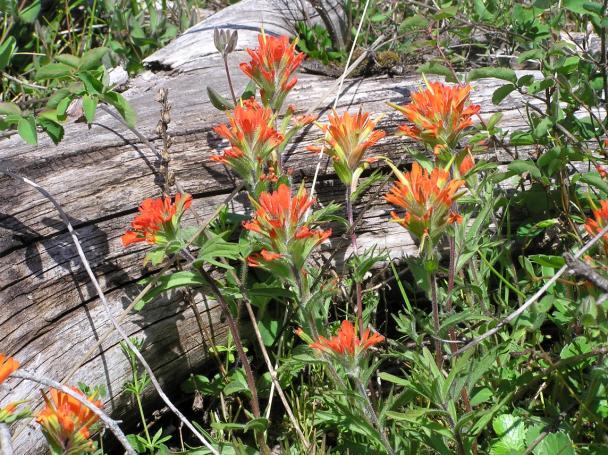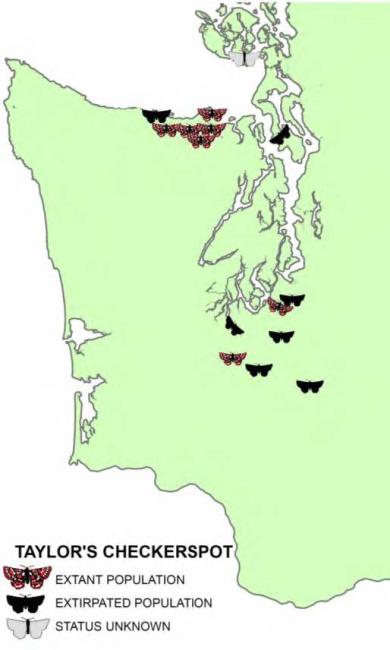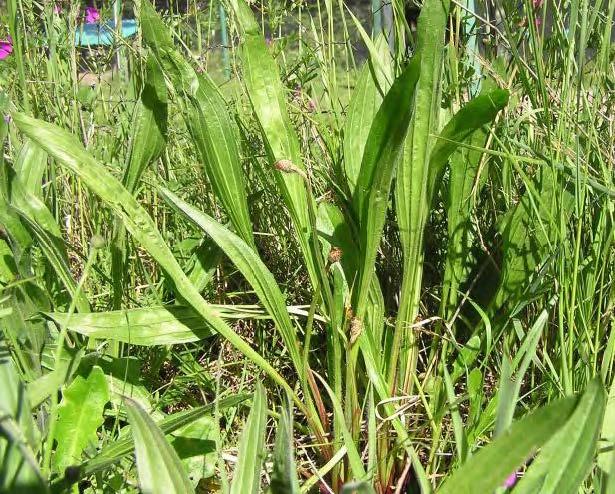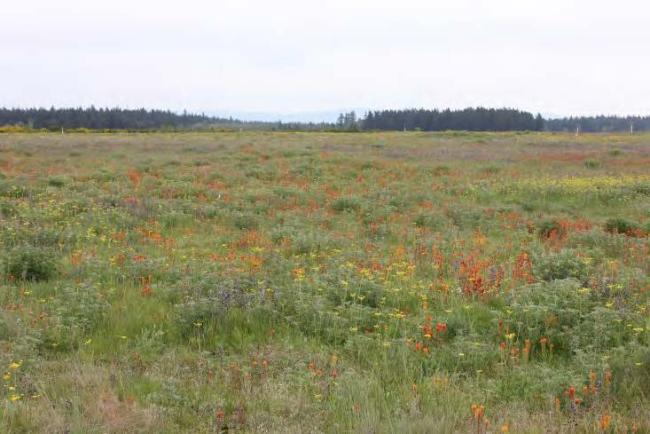Taylor's Checkerspot (Euphydryas editha taylori)
This article was originally published by the Washington Department of Fish and Wildlife as part of its annual report Threatened and Endangered Wildlife in Washington.

State Status: Endangered, 2006
Federal Status: Candidate, 2001
Recovery Plans: None
Taylor’s checkerspot, a subspecies of Edith’s checkerspot, is a medium-sized butterfly with a striking checkered pattern of orange to brick red, black and cream (Figure 1). It was historically found on grassland habitats from southeastern Vancouver Island, British Columbia, through the southern Willamette Valley in Oregon. This included over 40 known locations in Washington from the San Juan Islands south to the Cowlitz River in Lewis County (Stinson 2005). They were once so numerous that Dornfeld (1980) described Willamette Valley meadows as “fairly swarming” with checkerspots. The subspecies is now restricted to a small scattering of about seven populations in Washington, one population in British Columbia, and two populations in Oregon. Sites occupied by Taylor’s checkerspot included balds, coastal bluffs, and estuarine grasslands along the Strait of Juan de Fuca in Clallam County as well as prairies and balds in Thurston, Mason, Pierce, and Lewis counties. The subspecies became a candidate for listing under the federal Endangered Species Act in 2001 (USFWS 2001).
Females emerge in the spring and lay eggs on host plants of the family Scrophulariaceae, which are often specific to sites (or populations); these include harsh paintbrush (Castilleja hispida; Figure 3), marsh speedwell (Veronica scutellata), American brooklime (V. beccabunga), and non- natives including plantains (Plantago lanceolata, Figure 4, and P. major) and thyme-leaved speedwell (V. serpyllifolia ssp. serpyllifolia). When the caterpillars emerge, they depend on these primary host species for food until early summer, when they enter an inactive diapause stage.
Emerging from diapause in late winter, the caterpillars feed more broadly on the primary hosts and other post-diapause food plants that may be available, including sea blush (Plectritis congesta), blue-eyed Marys (Collinsia parviflora and C. grandiflora), and dwarf owl-clover (Triphysaria pusilla).
The decline of Taylor’s checkerspot in Washington has accompanied the loss of prairie and grassland habitats. As with other grassland-dependent species, forest encroachment together with invasion by non-native grass and forb species have degraded checkerspot habitat (Stinson 2005, Schultz et al. 2011). Severns and Warren (2008) describe loss of habitat in a 0.5 ha occupied patch resulting from invasive grass, and suggest that invasive grasses led to extinction of other historically sites. Extensive habitat management, including herbicide, mowing, prescribed burning, and nectar and host-plant enhancement, is needed to restore the larval food and nectar plants required for the species’ survival. Several occupied sites are on public lands, but are affected by recreation, military training, wildfires, and habitat degradation by exotic plants. The survival of the subspecies requires protecting and maintaining grassland habitat at existing sites, restoring habitat on degraded historical prairie, and reintroducting butterflies to establish additional populations.
Planning. An Interim Conservation Strategy is being prepared by WDFW and is expected to be completed in 2013. The purpose of the document is to direct conservation actions until a more complete recovery plan can be developed. In addition, an Action Plan is updated annually by the Taylor’s checkerspot Working Group to prioritize a list of short-term (2-3 year) conservation actions needed to secure the species status. Current conservation actions include developing statistically robust monitoring methods, monitoring extant populations and recently occupied sites, and conducting surveys to locate additional extant sites.
WDFW is also working with Olympic National Forest to develop checkerspot management plans for occupied sites on Forest Service lands, and habitat management efforts for one site were initiated in 2011. WDNR and WDFW completed a management plan in 2011 for four Taylor’s checkerspot sites on lands managed by WDNR in Clallam County. The plan includes site-specific management to minimize and mitigate the potential impacts to checkerspots and their habitat from timber harvest, silviculture, road maintenance, fire management, public use, and other activities.
Site specific restoration plans that outline tasks and actions that will develop suitable habitat for Taylor’s checkerspot (as well as Mardon skipper, streaked horned lark and Mazama pocket gopher) are being developed by a team of land managers, with input from species specialists (Dunn 2011). To date, final plans have been developed for Scatter Creek Wildlife Area, Tenalquot Prairie Preserve, Mima Mounds NAP, Rocky Prairie NAP, Bald Hill NAP, and Wolf Haven and a draft plan has been developed for West Rocky Prairie Wildlife Area. An early draft plan is being developed for Glacial Heritage Preserve.
Status and listing. In October 2012, the USFWS published a proposed rule to list the Taylor’s checkerspot as endangered under the federal Endangered Species Act; the proposed rule would also designate 6,000 ac of critical habitat (USFWS 2012). A final rule is expected in September 2013.
Captive propagation and reintroduction. A major part of WDFW’s recovery program for Taylor’s checkerspot involves captive propagation and translocation to re-establish additional populations on Puget Sound prairies (Linders 2011, 2012). The objective of this project is to establish at least three populations on three sites in the next decade. The Oregon Zoo has developed captive propagation techniques (Barclay et al. 2009). A second captive-rearing facility, Mission Creek Corrections Center for Women, began rearing Taylor’s checkerspot in 2012 as part of the Sustainability in Prisons Project, operated via The Evergreen State College. The captive rearing institutions have demonstrated high degree of success rearing larvae, mating adults and producing eggs. Two sites have received multiple releases of Taylor’s checkerspot caterpillars (larvae) and/or adult butterflies since 2009 (Figure 5-8). Captive rearing and reintroduction combined with intensive habitat management has met with preliminary success. Larval releases have consistently produced adult butterflies with normal foraging, basking, mating, and ovipositioning behaviors. After two years of release, one site produced densities comparable to the extant Puget lowland site; no new releases have occurred since 2011 and numbers remain promising. Numbers at a second release site have not increased yet, but the site produces and retains a small population of adults.
In 2012, two new sites were selected for reintroduction from a suite of historic and potential sites within the known range of Taylor’s checkerspot in South Puget Sound. A total of 2,540 postdiapause larvae were released in March, and 133 adults were released from captivity in May 2012, bringing the total to more than 15,000 larvae and 500 adults released since the program was initiated.
Each reintroduction site is expected to require multiple years of release followed by 5 years of monitoring to confirm population establishment. Long-term monitoring goals to measure progress toward population establishment were developed in 2012 based on population data from an extant site. Other project cooperators include US Fish and Wildlife Service, Joint Base Lewis-McChord, the Center for Natural Lands Management (CNLM), and WDNR-Natural Heritage Program.
Genetics project. A cooperative genetic research project involving the U.S. Forest Service, U.S. Fish and Wildlife Service, WDFW, and Washington State University-Vancouver was initiated in 2011 to investigate the genetic health, structure, and phylogenetic relationships of Taylor’s checkerspot populations. Molecular markers will be used to assess genetic diversity and population structure across the range of the species and to determine if any of the disjunct populations should be designated as separate subspecies. Results are anticipated in 2013.
Habitat enhancement. Butterfly conservation is usually best accomplished through habitat preservation, in part, because their numbers cannot be readily managed (New et al. 1995). In order to enhance habitat at occupied and reintroduction sites, techniques for establishing host plants, controlling weeds, and controlling shrubs are being developed and tested, and routine maintenance of prairie vegetation, such as prescribed burns and control of Scotch broom are ongoing at several sites on public lands. In 2011, WDFW completed a three-year project that enhanced occupied checkerspot habitat on state and private lands in Clallam County (Hays 2011). This WDFW/USFWS partnership included controlling exotic vegetation, establishing nectar plants, and removing trees and shrubs to maintain meadows and protect larval food plants.
To enhance and increase habitat for Taylor’s checkerspot on the Bald Hill Natural Area Preserve, WDNR-Natural Heritage Program has been conducting various treatments since 2007 (Wilderman and Davenport 2011). Actions included conifer removal on several acres, shrub control on 3 acres, treatment of orchard grass on 1 acre, and direct seeding and planting of plugs of several plant species important for Taylor’s checkerspot in 2010 and 2011.
Habitat restoration to support reintroduction of Taylor's checkerspot is a primary goal of the Unoccupied Butterfly Habitat Enhancement project funded by the Joint Base Lewis McChord ACUB Program, with additional funding from the US Fish and Wildlife Service (Dunn and Fimbel 2012). Many formerly occupied prairie sites do not currently support appropriate habitat and non-native grasses and forbs have established dense populations. The goal of the project is to efficiently restore a habitat condition adequate for Taylor's checkerspot reintroduction within identified management units on Glacial Heritage Preserve, Tenalquot Prairie, West Rocky and Scatter Creek Wildlife Areas, Mima Mounds and Rocky Prairie NAPs, and Wolf Haven International. A team of land managers has been implementing prescribed fire, weed control treatments and enhancing habitat through seeding and planting at these sites; from 2008- 2011, they enhanced targeted sites with >250,000 seedlings and 110 kg of seed. During fall 2012, CNLM staff, volunteers, and Americorps, planted more than 66,000 seedling plugs and over 50 pounds of native seed on Thurston County prairies; and similar amounts on JBLM prairies in preparation for upcoming Taylor’s checkerspot reintroductions (Fig. 9). Funding from JBLM’s Fish and Wildlife program supports complementary restoration efforts on JBLM prairies, including Ranges 76 and 50, Training Areas 7S, 14, 15 and Johnson Prairie. CNLM produces about 200,000 seedlings per year for these efforts. The scale and success of restoration on JBLM prairies is significant and several of these sites offer prime opportunities for reintroduction.
Research. Research into oviposition preference by Taylor’s checkerspot is occurring at the Mission Creek captive rearing facility under the guidance of a graduate student from The Evergreen State College. Initial results indicate that females prefer to oviposit on the natives, harsh paintbrush (Castilleja hispida) and golden paintbrush (C. levisecta) equally over the non-native English plantain (Plantago lanceolata). Golden paintbrush is a federally threatened species which USFWS has been aggressively restoring across numerous historic locales throughout the Puget Trough and in Oregon. Severns and Grosboll (2011) investigated patterns of reproduction and habitat use in four populations of Taylor’s checkerspot in Washington to identify and quantify habitat conditions that are associated with, as well as, conditions that discourage butterfly oviposition. Identification of reproductive habitat and characterization of the conditions will aid site-specific management, habitat restoration, assessment of reintroduction site suitability. Understanding patterns of pre-diapause host plant use is important because only the presence of pre-diapause plants will result in colonization. Bennett et al. (2011) reported observations of patrolling and perching, and evidence of mate-guarding behavior in Taylor’s checkerspot at sites in Oregon and Washington. Dunwiddie and Bakker (2011) review recent efforts in restoration of the Willamette Valley- Puget Trough-Georgia basin prairie and oak-dominated habitats.
Russell and Schultz (2010) and LaBar and Schultz (2012) investigated the effects of grass-specific herbicides on butterflies using Puget blues (Icaricia (Plebejus) icarioides blackmorei Barnes and McDunnough) and Cabbage whites (Pieris rapae) as a model species. Herbicides are an essential tool in restoring habitat for Taylor’s checkerspot. A review and strategy document is in preparation by experts in butterfly conservation and will be completed in 2013. Recommendations for research and monitoring were completed in 2012 (Weiss 2013).
Taylor’s Checkerspot Working Group. The Center for Natural Land Management coordinates annual meetings of a range-wide interagency Taylor’s checkerspot working group aimed at information exchange, cooperative conservation and promotion and prioritization of recovery actions.
Acquisition. In 2012, a 152 ac site in Clallam County occupied by Taylor’s checkerspot was acquired for conservation, and will initially be managed by CNLM.
Partners and cooperators: Oregon Zoo, Evergreen State College Sustainable Prisons Project, Mission Creek Corrections Center for Women (Washington Department of Corrections), U.S. Fish and Wildlife Service, Joint Base Lewis-McChord, Center for Natural Lands Management, U. S. Forest Service- Olympic National Forest, U.S. Natural Resources Conservation Service, Xerces Society, U.S. Forest Service-Genetics Lab, Washington State University-Vancouver, Washington Department of Natural Resources, Weyerhaeuser, Thurston County, Wolf Haven International, University of Washington.
Literature Cited
Barclay, E., M. Arnold, M. Andersen, and D. Shepherdson. 2009. Husbandry manual: Taylor’s checkerspot (Euphydryas editha taylori). September 2009, 1st edition. Oregon Zoo, Portland, Oregon.
Dornfeld, E. J. 1980. Butterflies of Oregon. Timber Press, Forest Grove, Oregon. 276 pp.
Dunn, P., D. Hays, D. Wilderman. 2011. Restoration Plans for ACUB Lands. ACUB Progress Report. 3 pp.
Dunn, P., and C. Fimbel 2012. Unoccupied butterfly habitat enhancement. Annual Progress report to ACUB Cooperators. Center for Natural lands Management.
Dunwiddie, P., and J. D. Bakker. 2011. The future of restoration and management of prairie-oak ecosystems in the Pacific Northwest. Northwest Science 85:83-92.
Hays, D. W. 2011. Conservation of Taylor’s checkerspot on the Olympic Peninsula. Report submitted to the U.S. Fish and Wildlife Service. 38pp.
Hellmann, J. J., S. B. Weiss, J. F. McLaughlin, P.R. Ehrlich, D.D. Murphy, and A. E. Launer. 2004. Structure and dynamics of Euphydryas editha populations. Pages 34-62, in P. R. Ehrlich and I. Hanski. (eds) On the wing of checkerspots: a model system for population biology. Oxford University Press. 371 pp.
LaBar, C. C., and C. B. Schultz. 2011. Investigating the use of herbicides to control invasive grasses in prairie habitats: effects on non-target butterflies. Natural Areas Journal 32:177-189.
Linders, M. 2011. Restoring Taylor’s Checkerspots to Historical Locales in Puget Lowland Prairies: Acting on Unexpected Opportunities for Conservation. Appendix 5, in: Schultz, C. B., E. Henry, A. Carleton, T. Hicks, R. Thomas, A. Potter, M. Collins, M. Linders, C. Fimbel, S. Black, H. E. Anderson, G. Diehl, S. Hamman, R. Gilbert, J. Foster, D. Hays, D. Wilderman, R. Davenport, E. Steel, N. Page, P. L. Lilley, J. Heron, N. Kroeker, C. Webb and B. Reader. 2011. Conservation of prairie-oak butterflies in Oregon, Washington, and British Columbia. Northwest Science 85:361–388.
Linders, M. J. 2012. Captive rearing and translocation of Taylor's checkerspot in south Puget Sound: 2011-2012. 2012 ACUB Annual progress report. Report to the ACUB Technical Review Committee. 20 September 2011. 29 pp. +appendices.
New, T. R., R. M. Pyle, J. A. Thomas, C. D. Thomas, P. C. Hammond. 1995. Butterfly conservation management. Annual Review of Entomology 40:57-83.
Russell, C., and C. B. Schultz. 2010. Investigating the use of herbicides to control invasive grasses: effects on at-risk butterflies. Journal of Insect Conservation 14:53-63.
Schultz, C. B., E. Henry, A. Carleton, T. Hicks, R. Thomas, A. Potter, M. Collins, M. Linders, C. Fimbel, S. Black, H. E. Anderson, G. Diehl, S. Hamman, R. Gilbert, J. Foster, D. Hays, D. Wilderman, R. Davenport, E. Steel, N. Page, P. L. Lilley, J. Heron, N. Kroeker, C. Webb and B. Reader. 2011. Conservation of prairie- oak butterflies in Oregon, Washington, and British Columbia. Northwest Science 85:361–388.
Severns, P.M. and A.D. Warren. 2008. Selectively eliminating and conserving exotic plants to save an endangered species from local extinction. Animal Conservation 11:476-483.
Severns. P.M and D. Grosboll. 2011. Patterns of reproduction in four Washington State populations of Taylor’s checkespot (Euphydryas editha taylori) during the spring 2010. Report submitted to the Nature Conservancy. 81 pp.
Stinson, D. W. 2005. Washington State status report for the Mazama pocket gopher, streaked horned lark, and Taylor’s checkerspot. Washington Department of Fish and Wildlife, Olympia, Washington. 129 pp.
USFWS (U.S. Fish and Wildlife Service). 2001. Endangered and threatened wildlife and plants; review of plant and animal species that are candidates or proposed for listing as endangered or threatened, annual notice of findings on recycles petitions, and annual description of progress on listing actions. Federal Register 66 (210):54808-54832.
USFWS (U.S. Fish and Wildlife Service). 2012. Endangered and Threatened Wildlife and Plants; Listing Taylor’s Checkerspot Butterfly and Streaked Horned Lark and Designation of Critical Habitat: Proposed Rule. Federal Register / Vol. 77, No. 197(Thursday, October 11, 2012): 61938-62058
WDFW (Washington Department of Fish and Wildlife). 2009. Guidelines for protecting the Taylor’s checkerspot and its habitat. Washington Department of Fish and Wildlife, Olympia, Washington. 6 pp.
Weiss, S. 2013. Ideas for research and monitoring for Taylor’s Checkerspot Butterflies in South Puget Sound Lowlands. Creekside Center for Earth Observation. Report submitted to Center for Natural Lands Management.
Wilderman, D. and B. Davenport. 2011. Taylor’s checkerspot habitat enhancement, Bald Hill Natural Area Preserve. FY11 ACUB Project, Washington Department of Natural Resources 11 pp.
Source: Washington Department of Fish and Wildlife. 2013. Threatened and Endangered Wildlife in Washington: 2012 Annual Report. Listing and Recovery Section, Wildlife Program, Washington Department of Fish and Wildlife, Olympia. 251 pp.











